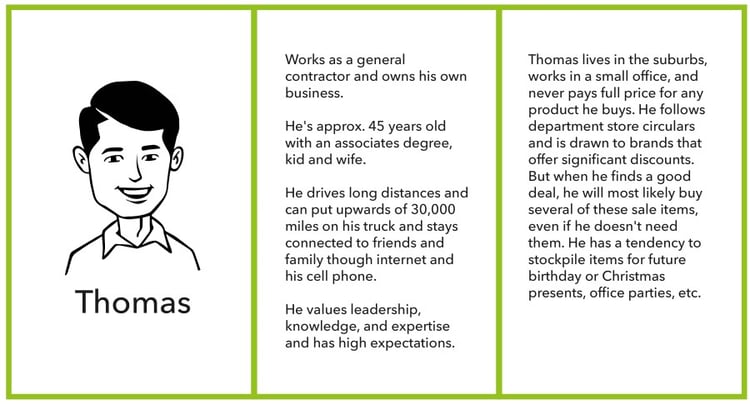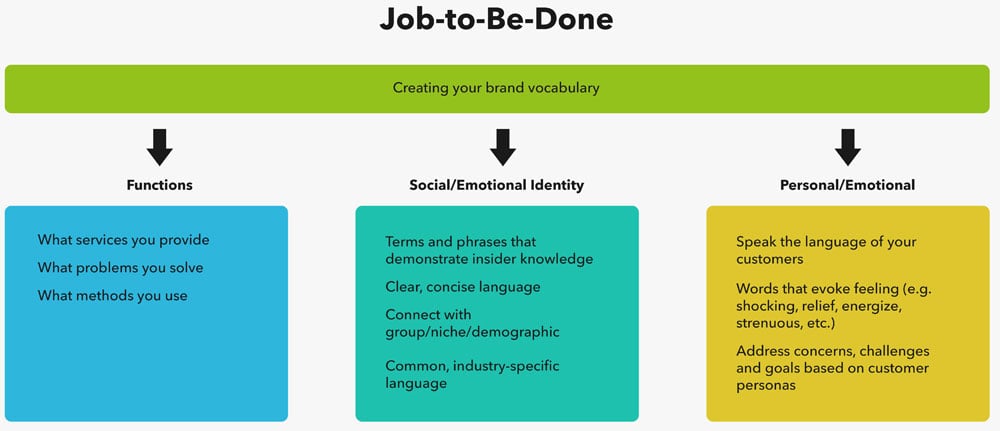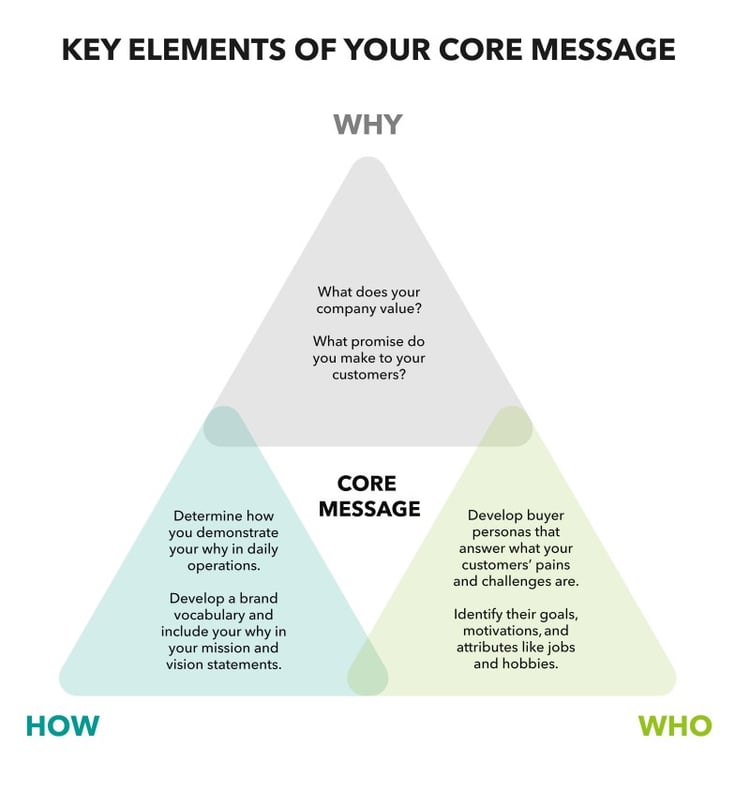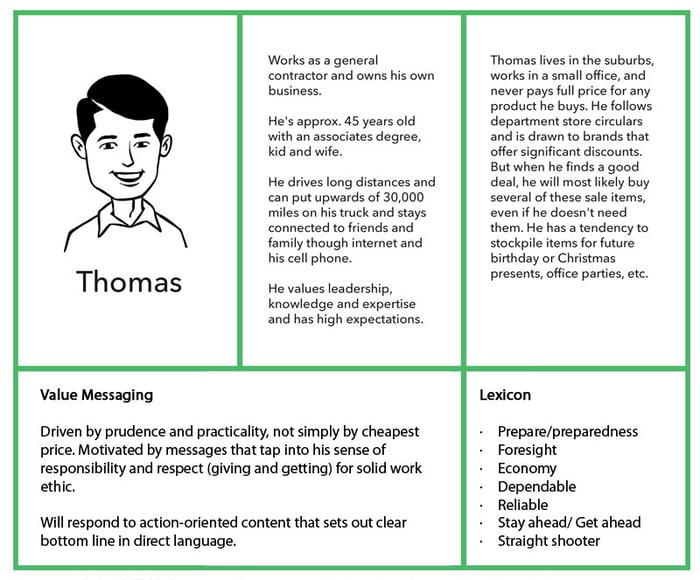Companies spend a lot on marketing. According to CMO Survey – Special COVID-19 Edition, marketing budgets now take up the highest percentage of companies’ revenue and budgets. This is true even as revenue and budgets have gotten smaller since the pandemic began. The fight for companies to get their share of rebound spending is real.
When you're spending that much on marketing, it's critical to get things right. There will always be campaigns that didn't work great or ads that didn't bring in the quality leads you wanted. Trying new offers, new copy, and new ideas is a natural part of marketing.
However, every new marketing effort needs to stand on a firm foundation: Great messaging. If your marketing doesn't have the fundamentals of great messaging down, all your marketing is hit or miss. That will get expensive.
Great messaging starts with understanding your "why." Simon Sinek says that a company has to "Start with the Why" in order to be successful. When you can lock down the "why" of your business, it becomes easier to clarify the value of what you provide to customers, beyond the tangible services and products you provide. You sell flooring and/or flooring installation services. That's easy to say. But when you think about why your company does what it does first, you start the conversation that looks behind your service or product to find the unique value your customers enjoy because they hired you.
All right, so far this sounds like self-indulgent navel-gazing. It's not. Throughout this article, we'll get specific on what great messaging and a strong message framework look like, how to develop a foundational message and vocabulary, and what types of content align with the different parts of that message framework.
The Basics of the "Why" and Its Core Message
Using Sinek's framework, he defines the "why" as your company's vision. Why it does what it does. In today's marketing world, a company is never just a company. It's also a brand. Broader than mere reputation, your company brand is the feeling and attitude people associate with your company.
When you're doing marketing right, people respond to your company/brand in the way you intend. So you need to be intentional about your messaging. What values does your company represent? What promise is your company making to its customers, vendors, staff, and community? Answering these questions with specificity is the way to start clarifying your "why." Most importantly, you need to answer why that "why" matters to these different groups of people.
With a clear “why,” you can start detailing the "how." How you deliver on your company values and promises. You're looking for real-world applications of your company's unique value, not just words. Let's say one of your company values is being trustworthy. How does trustworthiness show up in your company's actions? Does it mean providing accurate quotes and budgets? Does it mean schedules and deadlines are met?
That's how specific your answers should get. From there, you'll take a step back up to find the vocabulary that expresses both the "why" and "how." An effective way to start building this vocabulary is to write short, core content like a vision statement, tagline, or slogan. Done right, these types of content can express your "why" and "how" in a simple, memorable way.
These short pieces of content are the ideal place to start building a message framework because they really force you to get concise and precise with your language. They also form the core of all your other messages, which can vary in detail for different services or campaigns. That's what makes this initial "why" and "how" messaging your core messaging. Every other message, communication, and interaction should be built on this core messaging foundation.
Whatever values, promises, and image you want your company to project, all great core messaging shares two necessary qualities: It's memorable and is used consistently.
Memorable means it does more than deliver information. The message delivers a feeling and expectation that sticks with people.
Consistent means that it's used throughout all communications. Even when the exact tagline or value statement isn't an explicit part of the communication, the fundamental essence of the core message principles and promises are there. Everything, even seasonal specials ads, customer phone calls, and how-to videos, is steeped in your core message.
Achieving this sort of strategic messaging framework takes some upfront work, but makes delivering effective marketing, sales, and customer service much easier in the long run.
Before Any Words: Clarifying Brand Values and Promise
Part of clarifying your company's unique value and its brand promise is understanding who you're trying to reach. Building buyer personas and characterizing your target market are essential steps to developing a promise and language that will resonate with them.
 As you detail who your buyers are, pay particular attention to their fears and concerns related to flooring work. Whether they're homeowners, house flippers, or general contractors, what worries them when having to buy flooring or having flooring installed? On the flip side, what could a flooring installer do that would make their lives easier? How can you add unexpected yet welcomed value to the sales, delivery, or installation process?
As you detail who your buyers are, pay particular attention to their fears and concerns related to flooring work. Whether they're homeowners, house flippers, or general contractors, what worries them when having to buy flooring or having flooring installed? On the flip side, what could a flooring installer do that would make their lives easier? How can you add unexpected yet welcomed value to the sales, delivery, or installation process?
A scary part of this process is finding out how your company is currently perceived by its customers, its prospects, and in the community. You can do this through surveys and reading online reviews. Interview some past vendors and prospects who didn't contract with you. You may find your brand perception is not at all what you want it to be. You may be completely surprised by what people most appreciate about your team. All the information you learn here -- the good, the bad, and the ugly -- is instructive. Pay particular attention to the words they use. That will come in handy when it's time to build a brand vocabulary.
Combine this target market information with competitor research. The purpose here is to differentiate your company. What are other flooring companies doing? What are their core messages? What are they promising? How do you differ from them? What can you do or provide that they can't?
You might discover your company has distinctive values or promises. Great! However, you may find some competitors touch on values that animate your company's "why." Using our trustworthiness example, you don't need to cede that ground if another local flooring company touts their trustworthiness. You will need to find a unique (and better) way to communicate and live that value for your customers' benefit.
Finding the Right Words: Developing a Lexicon for Effective Messaging
An effective message starts with one simple theme. Marketing messages that are too messy or complicated get ignored or forgotten. People have a lot going on in their minds. They aren't going to take the time to decipher a long, wide-ranging, or muddled message.

As you draw on your core messaging to build more specific marketing messages for different services, products, and campaigns, keep each message focused on a single idea. Don't distract from it by throwing in other themes.
Since messaging is how you talk about your company, the exact words do matter – even if the point isn't to get people to memorize your slogan (although that's nice, too). When you're first formulating your vision statement or short company description, start with getting the ideas on paper. From there you can refine them into the actual words used.
Keeping a marketing message concise helps you stay on theme. It also forces you to choose high-impact words. When you draft your tagline for a product, you should know why every word in that message is there and how it contributes to strengthening the message.
High-impact words are those that spark emotion or an image in one's mind. People don't connect with facts. Facts and validation are useful to support a message, but they aren't the message. People connect with how they feel about something and what they envision that message means for them.
You also want to make sure that the high-impact words and phrases are ones that are meaningful to the intended audience. Remember the discussion on your discovery process to find out what prospects, customers, and others think about your company? Now that you're ready to build a messaging vocabulary, going back to the exact words you heard during this process will be invaluable.
Paying attention to how people talk about what matters to them will help you communicate with them in their own language. For example, if people were describing poor scheduling as one of their pain points when working with home contractors, you may have heard this frustration expressed as the desire that they "respect my time." There's no reason at all why you can't incorporate this phrase into your messaging.
Once you've completed your core messaging, you probably have a list of discarded words and phrases. They were on-point and descriptive, but just didn't make it into a concise statement. These words are the start of your lexicon. You didn't think I meant it when I wrote you'll build a messaging vocabulary, did you? That's exactly what I meant.
We often develop detailed style guides for clients. You can create a company style guide with outside help or put together a short one on your own. Either way, creating a list of preferred words and phrases that hit the right tone for your company brand is integral to achieving consistency in all your messaging. Equally important is specifying the words and phrases you don't want used because they clash with the core messages you want to deliver. For example, your company may always deliver "best pricing" or "highest ROI," but you don't offer "cheap" or "low" pricing.
Hopefully, you can start to see how having core messages and message lexicon facilitates the creation of your targeted marketing messages. I've been dancing around this process of building a strategic message framework and using it to develop more targeted marketing messages; now it's time to get to it.
Exploring the Building Blocks of a Message Framework
The foundational core messages are the company-level messages. Core messages bring together the "why" and share the top-level "how" and "who." You don't need every type of foundational core message, but you do need at least two so they can do the work of grounding the rest of your marketing messages. Common types of core messaging are a vision statement, branding promise, tag line, and slogans. Positioning statements and elevator pitches are slightly more detailed types of core message content.

- WHY
- What does your company value?
- What promise do you make to your customers?
- HOW
- Determine how you demonstrate your why in daily operations.
- Develop a brand vocabulary and include your why in you mission and vision statements.
- WHO
- Develop buyer personas that describe their pains and challenges.
- Identify their goals, motivations, hobbies, and where they hang out online.
Your core messaging should deliver the why, how, and who in concise language that sticks with people. It should reveal to them the values that animate your organization. Let’s look at Southwest Airlines' purpose and vision statements:
“Connect People to what’s important in their lives through friendly, reliable, low-cost air travel.”
“To be the world’s most loved, most efficient, and most profitable airline.”
Through their purpose statement, we instantly know what animates their motivation. In these two short statements, Southwest Airlines speaks to three constituencies; its passengers, its workers, and its shareholders. They clearly reflect its values of treating people well, working hard, and working smart. (You can see their other core messaging here.)
After you’ve gone through the process of setting out your organization’s values, purpose, and vision and are ready to build a core messaging framework, the result should look something like this:
| Core Message # 1 (ex. Vision or Purpose Statement) |
||
| Core Message #2 (ex. Vision or Purpose Statement; possibly a tagline or slogan) |
||
| Optional Core Message #3 | ||
| Optional Core Message: Elevator Pitch (around 70 words, or 30 seconds) |
||
| Value #1 | Value #2 | Value #3 |
| Describe what each value looks like in practice. | How does each value show up in the choices the organization makes and how its people conduct themselves? | Explain how each value supports the customers and how it makes them feel. Why do they share this value? |
| Share a short list of words and phrases from your lexicon that represent each value. | May also include some words and phrases that contradict each value and should not show up in any messaging. | |
You can certainly have more than three core values. However, if your value list grows quite long, take a look at where some touch on the same deeper value and group them together. You can use a similar framework to express this more detailed picture of your organization’s values in your style guide. That might look something like this:
| Core Value #1 | Core Value #2 | Core Value #3 | Core Value #4 | Core Value #5 |
| Add short reminder about why this value is important | ||||
| Bullet list the relevant supporting values under each core value | An alternative to separating out the vocabulary list would be to give each supporting value its own cell, which could include relevant examples of the lexicon for that specific value | |||
| Bullet list the approved vocabulary for this core value |
You can use a similar format to present the full lexicon you developed for each value, regardless of how many values you identify. When you have these frameworks built for your core messaging, you can start spinning it out into greater detail that apply under different circumstances. For example, each of your personas should have their own messaging component.

| HARDWOOD FLOORING | ||
| Core message #1 (mission or position statement) |
||
| Core message #2 (tagline or elevator pitch) |
||
| Value #1 | Value #2 | Value #3 |
| Short description of each value; how it shows up in this offering, and relevant vocabulary | ||
| Specific offerings, e.g | ||
| Solid Woods | Engineered Woods | Restoration |
| Can add descriptions of specific benefits and messaging | ||
| PERSONAS: (list relevant personas here) | ||
You can continue to drill down and create messaging frameworks for specific campaigns, such as a promotional special or production of premium content, such as a lead generator or a white paper. The goal of a more detailed framework is to identify a clear audience, a clear message, clear metrics for success, and specify a working lexicon for the campaign. Some additional questions these lower-level frameworks should answer include:
- What value(s) does this campaign or content represent?
- What problems does it solve for the customer or prospect?
- What is this campaign’s single core message?
- What is the goal or call-to-action?
- What personas are targeted?
Consult all the relevant, higher-level frameworks as you build out the message framework that sits on a more granular level. This ensures that you embed the values and achieve the messaging consistency so vital to maintaining your brand promise and creating a consistent brand experience. Nothing will undermine your efforts to build the solid brand reputation you want like inconsistency.
Making Sure Your “Why” Shows Up in All Your Messaging
The cascade approach to message development ensures that the “why” you specify is the root and seed of all your further messaging. The “why” is fundamentally who you are as an organization. It’s the “personality” the market attaches to you so they feel like they can connect with you. They aren’t going to connect to a hardwood floor. Customers and prospects buy from and work with people. When your why-based, strategic messaging personalizes your organization, you can connect with audiences in ways that inspire them to take action.


Submit a Comment
Your email address will not be published. Required fields are marked *